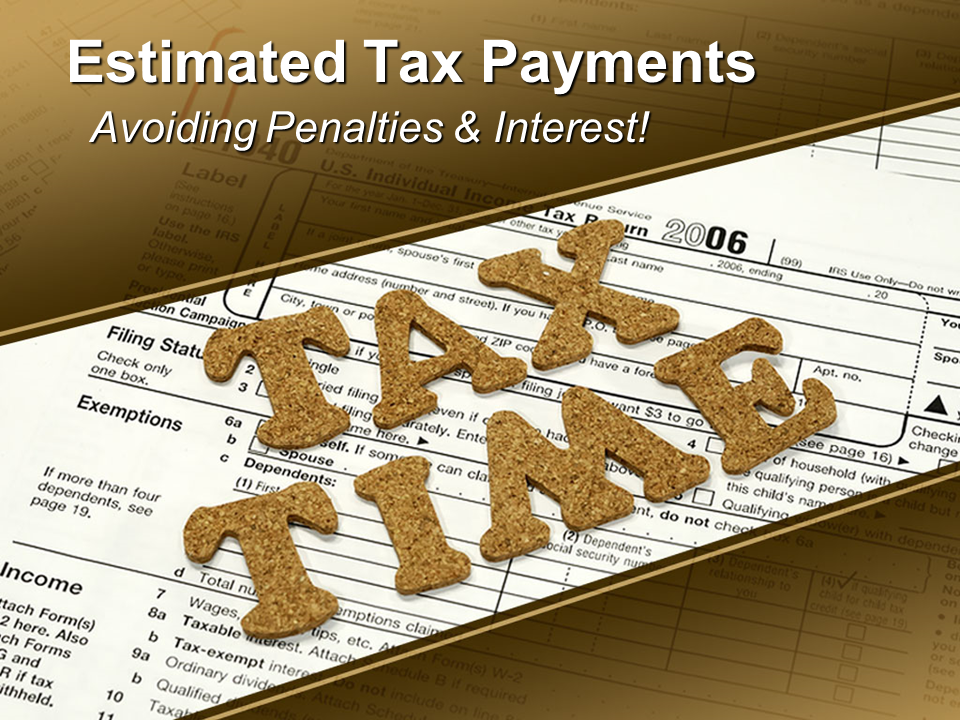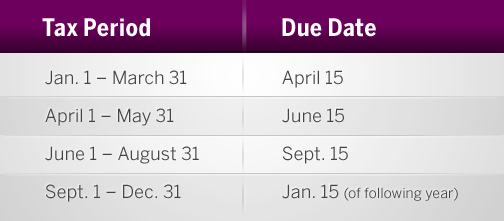
“I Just Love Paying Extra Money to the IRS!” -said nobody ever.
“I Just Love Paying Extra Money to the IRS!” -said nobody ever.
A few quarterly steps can save you some serious dough.
Taxes. It’s one of the only two certainties in life. Everybody makes tax prepayments throughout the year. If you’re an employee and get paid on a W2, taxes are withheld from each of your paychecks and given to the IRS as a prepayment of your annual tax bill. If not enough is withheld during the year, you end up owing additional money when you file by April 15. If you make money but are not paid on a W2, you should also be making prepayments towards your yearly tax bill. If you fail to make adequate prepayments throughout the year, you could end up owing extra money to the IRS in the form of a penalty when you make your yearly filing. Do you want to pay extra, unnecessary money to the government? I didn’t think so. Here’s what to do.
Who, me? Couldn’t be.
If you’re an entrepreneur, there’s a reasonable chance you may be required to make quarterly tax prepayments in order to avoid a penalty at the end of the year. Sole proprietors, people involved in partnerships, or owners of an S-corporation should make quarterly tax prepayments. Basically, if you receive a 1099, a K-1, or receive checks directly from clients that go into your pocket, you’re on the hook. Pay up now, or you’ll end up paying extra later. For more information on who has to pay and possible exclusions, check out the IRS’ site for the self- employed and small business owners.
So, how does this work?
There’s the easy way to do this, and the really easy way to do this. The easy way involves working your way through a quick worksheet. If you have your business’ financials handy from the prior year, it will make things go very quickly. Essentially, go to the worksheet, then answer the questions. It will help you compute your estimated taxes for the year. Then, break up the estimated amount into quarters, and pay that amount on each due date. It can help to save some money each month in a special savings account designated just for tax money. This will spread the expense across each month and make it part of your monthly business expenses. The really easy way to do this is to forgo the worksheet and just put 25%-30% of your monthly revenue into a savings account for the tax payments, then make the quarterly payments using that money.
When and how do you pay?

Estimated tax prepayments are due every quarter for earnings received during that quarter. The due dates for each installment are April 15, June 15, September 15, and January 15 of the following calendar year for income received the prior October through December. If you file your yearly taxes before January 15, you can waive the fourth installment and just pay it as a part of your yearly tax filing and payment.
There are several ways to pay your quarterly taxes. The two most common way to pay are online are through a direct payment or by enrolling in the Electronic Federal Tax Payment System. Additional ways to pay your monthly installments can be found on the Form 1040-ES worksheet on page four in the How To Pay Estimated Tax section. Payments can be made in cash, by phone, or via mail as well.
By bookmarking the links above, putting payment reminders on your calendar, and establishing an extra savings account, you’ll have great progress towards the goal of mastering your quarterly taxes. As always, your partners here at Team Duncan Financial are with you every step of the way. We can help you with calculations or answer any other questions you have about the quarterly tax process. The important part is to pay them. Otherwise, you’re just flushing money down the toilet. We all know that’s a bad idea.
—
Moloney Securities Co., Inc. is a Registered Broker-Dealer and Member FINRA & SIPC
Investment Advisory Services offered through Moloney Securities Asset Management, LLC, Registered Investment Adviser
Certified Financial Planner Board of Standards Inc. owns the certification marks CFP®, Certified Financial Planner™and federally registered CFP (with flame design) in the U.S., which it awards to individuals who successfully complete CFP Board’s initial and ongoing certification requirements.
The information contained in this website is not a complete analysis of every material fact with respect to any market, company, industry, security or investment. Opinions expressed are subject to change without notice. Statements of fact have been obtained from sources considered reliable but no representation is made by Moloney Securities Co., Inc., any of its affiliates or any representative of the company as to completeness or accuracy.
Nothing here should be construed as an offer to buy or sell, or solicitation of an offer to buy or sell any securities.
This communication is strictly intended for individuals residing in the state(s) of AK, AZ, CA, CO, CT, FL, IN, KS, MD, MA, MO, NM, OR, PA, TX, VTand WY. No offers may be made or accepted from any resident outside the specific states referenced.
Moloney Securities, Team Duncan, Financial DNA, https://financialdna.com/
Moloney Securities, Team Duncan, and the tools listed above are not affiliated entities.
IMPORTANT: The projections or other information in the tools listed above are hypothetical in nature, do not reflect actual investment results and are not guarantees of future results. Your results may not be representative of others. There is no guarantee of performance or success.



3 Responses to “I Just Love Paying Extra Money to the IRS!” -said nobody ever.